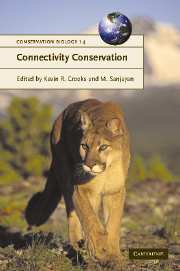Book contents
- Frontmatter
- Contents
- List of contributors
- Acknowledgements
- 1 Connectivity conservation: maintaining connections for nature
- PART I Approaches to connectivity research
- PART II Assessing connectivity
- PART III Challenges and implementation of connectivity conservation
- Introduction: Don't fence me in
- 18 Hyperconnectivity, invasive species, and the breakdown of barriers to dispersal
- 19 Disease and connectivity
- 20 Maintaining and restoring connectivity in landscapes fragmented by roads
- 21 Where to draw the line: integrating feasibility into connectivity planning
- 22 South Coast Missing Linkages: restoring connectivity to wildlands in the largest metropolitan area in the USA
- 23 Incorporating connectivity into broad-scale conservation planning
- 24 Escaping the minimalist trap: design and implementation of large-scale biodiversity corridors
- 25 The role of connectivity in Australian conservation
- 26 The future of connectivity conservation
- Index
- References
18 - Hyperconnectivity, invasive species, and the breakdown of barriers to dispersal
Published online by Cambridge University Press: 24 May 2010
- Frontmatter
- Contents
- List of contributors
- Acknowledgements
- 1 Connectivity conservation: maintaining connections for nature
- PART I Approaches to connectivity research
- PART II Assessing connectivity
- PART III Challenges and implementation of connectivity conservation
- Introduction: Don't fence me in
- 18 Hyperconnectivity, invasive species, and the breakdown of barriers to dispersal
- 19 Disease and connectivity
- 20 Maintaining and restoring connectivity in landscapes fragmented by roads
- 21 Where to draw the line: integrating feasibility into connectivity planning
- 22 South Coast Missing Linkages: restoring connectivity to wildlands in the largest metropolitan area in the USA
- 23 Incorporating connectivity into broad-scale conservation planning
- 24 Escaping the minimalist trap: design and implementation of large-scale biodiversity corridors
- 25 The role of connectivity in Australian conservation
- 26 The future of connectivity conservation
- Index
- References
Summary
INTRODUCTION
The conservation implications of connectivity arise at many spatial scales. At the regional or landscape level, decreasing connections between natural areas inhibit the movement of species dependent on those habitats. Therefore, current conservation efforts often focus on connecting systems and facilitating the exchange of organisms between otherwise isolated patches. This dispersal of individuals can benefit populations by promoting gene flow and decreasing local extinction risk. Although increasing connectivity at the regional level may have negative consequences, such as altering source–sink dynamics, preventing local adaptation, accelerating the transport of pathogens, and facilitating the localized spread of invaders (Simberloff et al. 1992), it is typically considered that the benefits of restoring connectivity outweigh the risks (Crooks and Sanjayan Chapter 1). Much of the current volume addresses the topic of maintaining or increasing connectivity of this type.
At a larger spatial scale, such as between continents, a different connectivity-related conservation concern arises. Because of the long distances involved, natural movement at these scales should be relatively rare. Species can naturally traverse long distances both passively (e.g., via ocean currents or air masses: Scheltema 1986; Censky et al. 1998; Ritchie and Rochester 2001; DiBacco et al. Chapter 8) and actively (e.g., through migration: Møller et al. 2003), and those few species that do make long-distance treks are often the target of conservation efforts (Harrison and Bjorndal Chapter 9; Marra et al. Chapter 7). Currently, however, the majority of global species movement does not occur naturally.
- Type
- Chapter
- Information
- Connectivity Conservation , pp. 451 - 478Publisher: Cambridge University PressPrint publication year: 2006
References
- 14
- Cited by



